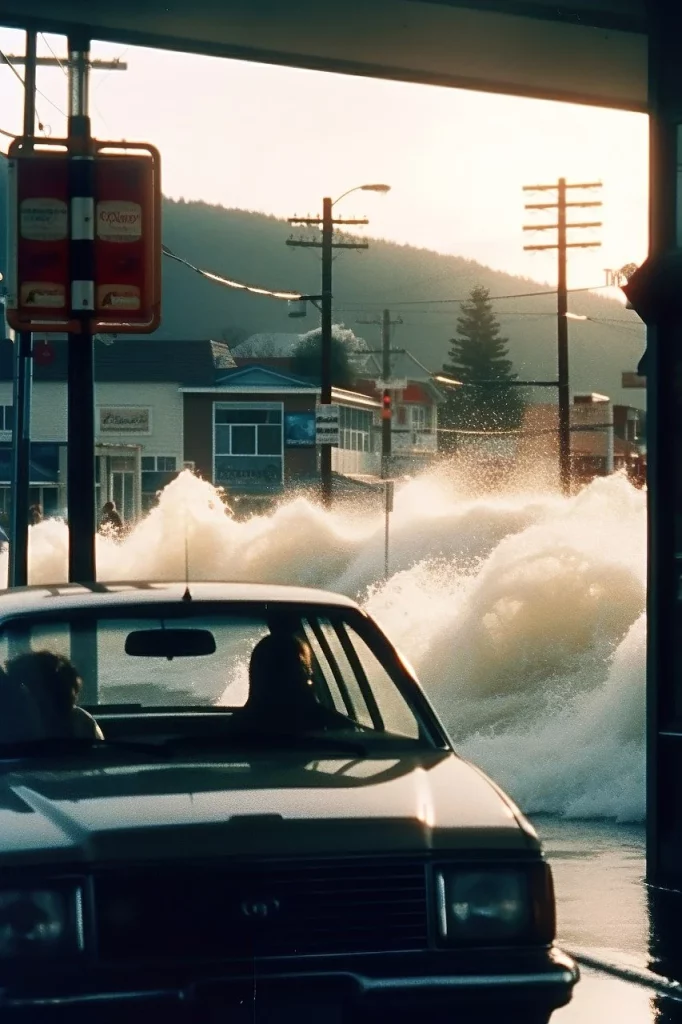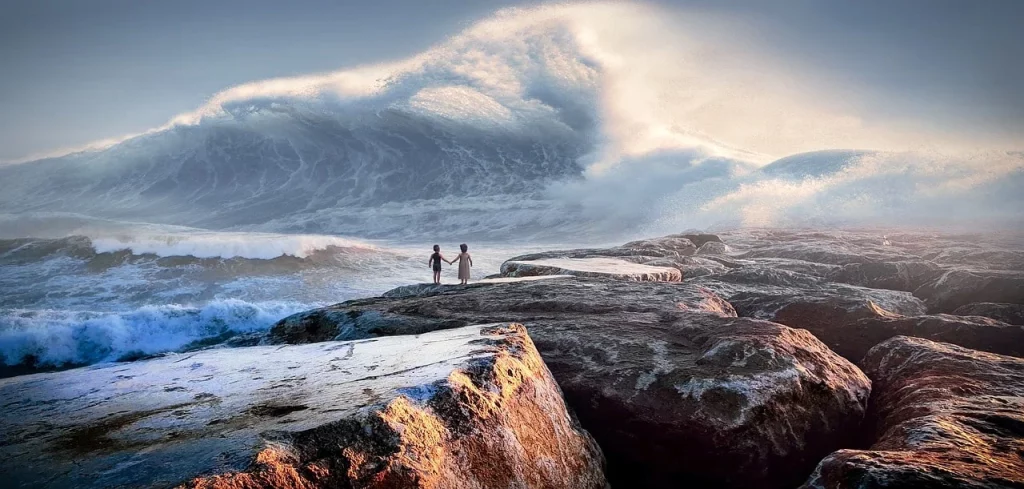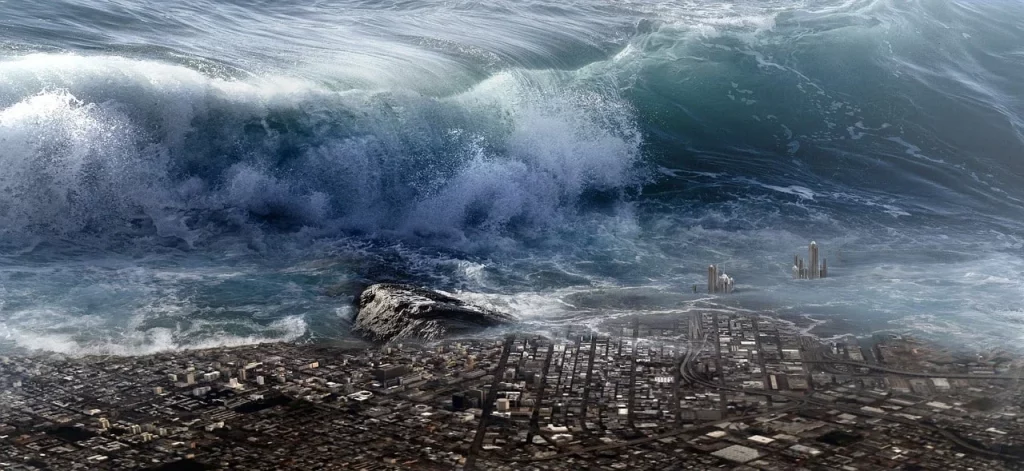Did you know that tsunamis can travel as fast as a jet plane over deep waters? Tsunamis, one of nature’s most formidable phenomena, are not merely large waves; they are complex events triggered by underwater earthquakes, volcanic eruptions, or landslides.
Our journey will uncover the mysteries behind these natural giants. We’ll learn about their causes, the science that predicts them, and the stories of survival and loss. Join us as we dive deep into the world of tsunamis and discover what makes them tick.
Tsunamis are reminders of the dynamic beauty of our planet.
Dr. Jane Goodall
Tsunami Facts
Before you embark on this informative journey through our carefully selected facts, remember that there’s a quiz waiting for you at the end of this page. Read thoroughly to prove your expertise on tsunamis.
- Over 23,000 atomic bombs of the Hiroshima type could match the energy unleashed by the 2004 Indian Ocean event.
- A tsunami can cruise through the ocean’s depths as fast as an airplane, reaching speeds of about 800 kilometers per hour (500 mph).
- Originating from Japan, the word tsunami merges “tsu” (harbor) with “nami” (wave), reflecting its nature.
- At sea, these waves might measure a mere 30 centimeters tall, yet they swell to towering heights near shore.
- Volcanic eruptions, glacier calvings, and seabed landslides also have the power to set off tsunamis, though earthquakes are the prime cause.
- The first documented occurrence was in 426 BC in the Aegean Sea, as recounted by the Greek historian Thucydides.
- In Japan, ancient markers caution against building below certain elevations, some dating back 600 years, serving as silent guardians against future disasters.
- The highest wave ever observed was in Lituya Bay, Alaska, in 1958, soaring to an astonishing 1,720 feet (524 meters).
- Established in 1949, the Pacific Tsunami Warning System uses seafloor sensors to foresee these natural phenomena.
- Erratic animal behaviors have been noted as potential precursors to these events, offering an intriguing natural warning system.
- A tsunami typically unleashes a series of waves, with the initial one not always being the most forceful.
- The aftermath can significantly heighten the risk of epidemic diseases due to contamination of freshwater sources.
- Contrary to popular belief, these are not tidal waves, as their genesis lies not in tidal forces but in geologic disturbances.

- The Doggerland catastrophe around 6100 BC was spawned by a massive undersea slide, reshaping the land bridge between Britain and mainland Europe.
- Mangrove forests and coral reefs can diminish the impact of these waves, acting as natural defense systems.
- Post-2011, in Japan, over 5 million tons of debris were dispatched into the ocean, with remnants reaching North American shores.
- Such waves can traverse the Pacific Ocean in under a day, a testament to their astonishing speed.
- The 2004 tragedy led to the establishment of the Indian Ocean Warning System, designed to alert surrounding nations of impending waves.
- A mysterious wave struck Japan in 1700, later linked to an earthquake along the U.S. Pacific Northwest, illustrating the global reach of these phenomena.
- Remarkably, these waves can ascend rivers, inflicting damage far inland from their oceanic origins.
- Archaeological discoveries suggest that ancient coastal communities were shaped—and sometimes erased—by tsunamis.
- The global adoption of the term followed the 1960 Chile quake, which underscored the need for a unified lingo to describe such disasters.
- Escaping to higher ground has proven a crucial survival tactic, as recounted in many survivor tales.
- Volcanic island collapses have occasionally outpaced earthquakes in generating the largest tsunamis, with the Santorini eruption as a prime example.
- DART buoys now play a pivotal role in real-time ocean monitoring, bolstering tsunami research and prediction capabilities.
- The concept of creating artificial tsunamis as warfare, explored during WWII, led to the investigation of a “tsunami bomb”.
- These natural catastrophes have been woven into folklore and mythology worldwide, often portrayed as divine or supernatural retribution.
- Coastal reforestation efforts are not merely environmental but also serve as tsunami mitigation strategies.

- The response to the 2004 Indian Ocean event mobilized one of the largest aid efforts in history, totaling over $14 billion.
- Warning systems now caution about potentially dangerous currents and unpredictable sea levels, beyond just the imminent wave threat.
- The Mediterranean, despite its tranquil appearance, holds a history of destructive tsunamis triggered by seismic activities.
- Climate change models suggest an uptick in tsunami frequency and intensity, driven by rising seas and more frequent geological upheavals.
- The nuclear crisis following the 2011 event in Japan highlighted the complex interplay between natural disasters and technological vulnerabilities.
- On occasion, the forces unleashed have unearthed historical artifacts, offering a silver lining in the form of archaeological insights.
- The sheer power can transform landscapes, obliterating man-made structures and natural formations alike.
- Comprehensive evacuation strategies are critical, teaching coastal dwellers the importance of quick, organized escapes.
- Environmental repercussions are profound, with significant habitat alteration and extensive debris dispersal.
- The shape of the coastline plays a crucial role in the impact, with certain topographies amplifying the wave’s force.

- Public education on these threats is vital, empowering individuals with the knowledge to react swiftly and effectively.
- The 1700 “orphan tsunami” in Japan, initially a mystery, later helped scientists understand the interconnectedness of global geological events.
- Advances in building design aim to create structures resilient to the immense forces of tsunamis, enhancing safety and reducing destruction.
- These events have spurred significant advancements in detection and warning systems, aiming to mitigate future risks.
- Survivors often face long-term psychological effects, underscoring the need for mental health support in the aftermath.
- Global collaboration among warning centers enhances preparedness, demonstrating the importance of shared knowledge and resources.
- Emerging research continues to refine our understanding of vulnerabilities, guiding efforts to protect against future tsunamis.
- Submarine canyons can act as conduits, amplifying the speed and power of a tsunami as it approaches land, highlighting the intricate underwater landscapes that influence wave behavior.
- The phenomenon of “drawback”, where water recedes dramatically from the shoreline just before a tsunami strikes, can serve as a natural warning sign, urging immediate evacuation to higher ground.
- In some instances, ancient tsunamis have been powerful enough to transport large boulders hundreds of meters inland, leaving geological evidence of their passage.
- Tsunami shelter buildings, designed to withstand the force of these waves, are becoming an integral part of coastal communities’ preparedness measures, offering safe havens in vulnerable areas.
- The integration of tsunami education into school curriculums in vulnerable regions aims to build a culture of awareness and readiness from a young age, ensuring future generations are better prepared for such events.
Tsunami Myths

Having explored all these interesting facts about tsunamis, let’s now navigate through the fog of myths and misconceptions. Our journey into separating truth from fiction begins here.
- Tsunamis are Giant Walls of Water
They are often depicted as massive vertical walls of water, but in reality, they’re more like a rapidly rising tide or a series of waves. The danger lies not in a towering wave but in the vast volume of water moving at high speed, which can inundate coastlines. - Only the Coastline Closest to the Earthquake is Affected
Although it’s commonly thought that only nearby areas are at risk, tsunamis can travel thousands of miles across oceans. The energy released by the seismic event can affect coastlines far from the epicenter, making distant regions vulnerable as well. - All Tsunamis Cause Catastrophic Damage
The impact varies greatly. While some can cause catastrophic damage, flattening buildings and taking lives, others may result in minimal changes that barely affect the coastal landscape. The specific geography of the area plays a significant role in determining the extent of the damage. - Tsunami Warnings Always Provide Ample Time to Evacuate
Despite advancements in early warning systems, the time between a tsunami warning and the arrival of the first wave can be very short. In some cases, the warning time may be insufficient for a safe evacuation, emphasizing the importance of emergency preparedness and immediate response. - Tsunamis are Only Caused by Earthquakes
While earthquakes are the most common cause, they can also be triggered by volcanic eruptions, underwater landslides, or even meteorite impacts. The key factor is the displacement of a large volume of water, which can be initiated by various geological events.
No products found.
Tsunami Quotes

The raw power of tsunamis has long captivated and terrified humanity. Let me share with you some of my favorite quotes about tsunamis. Feel free to share more in the comments so I can add them to the list.
The tsunami of information technology will sweep away everything before it.
Bill Gates
Bill Gates compares the overwhelming and unstoppable force of information technology to a tsunami, illustrating its transformative power.
A tsunami doesn’t obliterate; it reshapes.
Naomi Klein
Naomi Klein uses the metaphor of a tsunami to describe how catastrophic events can lead to significant changes and new beginnings.
In the wake of a tsunami, we see the true strength of communities.
Ban Ki-moon
Ban Ki-moon reflects on the resilience and solidarity of communities that come together to rebuild and support each other after the devastation caused by a tsunami.
Tsunamis are nature’s wake-up call to humanity.
Jacques Cousteau
Jacques Cousteau emphasizes that tsunamis serve as a stark reminder of the power of nature and the need for humans to respect and protect their environment.
Facing a tsunami is like facing the raw power of the earth; it’s both terrifying and fascinating.
James Cameron
James Cameron captures the dual nature of tsunamis as both a source of fear and a subject of human fascination, highlighting their undeniable power and the awe they inspire.
Tsunami FAQ

As we approach the final segment of our journey, the upcoming FAQ section serves as your last step before the quiz. Read carefully these answers to some common questions if you want to ace the following trivia.
- Can tsunamis be predicted?
While we can’t predict the exact time and location of a tsunami’s occurrence, advancements in earthquake and ocean monitoring allow us to issue tsunami warnings minutes after an underwater earthquake is detected, giving people in affected areas crucial time to evacuate. - Can tsunamis occur in any ocean or sea?
Yes, they can occur in any large body of water but are most common in the Pacific Ocean due to the frequent earthquakes and volcanic activity around the “Ring of Fire.” - How can you survive a tsunami?
If you’re in a coastal area and experience an earthquake, see an unusual retreat of ocean water, or receive a tsunami warning, evacuate immediately to higher ground or inland. Always follow local emergency instructions and have an emergency kit ready. - How are tsunamis measured or categorized?
They are measured by their wave height and the scale of damage they cause. Scientists use sea level gauges and buoy systems to measure the height of the waves in the open ocean and predict their potential impact on coastal areas. - Have there been any significant tsunamis in recent history?
One of the most significant recent ones occurred in 2004 in the Indian Ocean. It was caused by a powerful undersea earthquake off the coast of Sumatra, Indonesia, resulting in devastating waves that affected multiple countries and caused over 230,000 deaths.
No products found.
Tsunami Trivia

Dive into our tsunami quiz. Beware; fail to answer any questions right, and you might find yourself surfing on a rubber duck in the kiddie pool of knowledge!
Conclusion
Reflecting on tsunamis, we see the power of nature in full force, pushing us to innovate and adapt in the face of danger. These giant waves highlight the importance of global cooperation and the sharing of knowledge to combat natural disasters.
As we continue to learn and grow, let’s keep our spirits high and our preparations thorough. And to end on a humorous note, if tsunamis could be stopped with a magic spell, what silly word would you shout to activate them? Let me know in the comments.
1 Source Used For This Article

